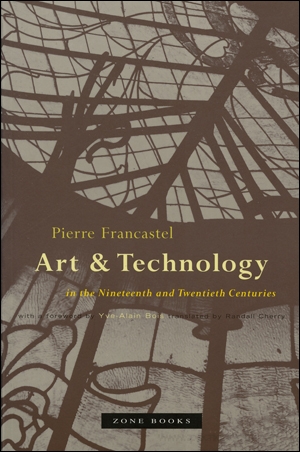Pierre Francastel: Art & Technology in the Nineteenth and Twentieth Centuries (1956–) [ES, EN]
Filed under book | Tags: · art history, design, design history, history of architecture, machine, technology

“Although the work of Pierre Francastel (1900-1970) has long carried the label “sociology of art,” it bears little resemblance to anything conventionally sociological. Unlike the followers of the dominant schools of Anglo-American and German art history, Francastel was never obsessed with establishing a quasi-scientific methodology as the basis for his studies. But as art history itself is being reconfigured amid the technological culture of the twenty-first century, his nuanced meditations from the 1950s on the intricate intersection of technology and art gain heightened value.
The concrete objects Francastel examines are for the most part from the architecture and design of the late nineteenth to mid-twentieth century. Through them, he engages his central problem: the abrupt historical collision between traditional symbol activities of human society and the appearance in the nineteenth century of unprecedented technological and industrial capabilities and forms.”
First published as Art et technique aux XIXe et XXe siècles, Paris, 1956.
English edition
With a Foreword by Yve-Alain Bois
Translated by Randall Cherry
Publisher Zone Books, New York, 2000
ISBN 1890951021, 9781890951023
331 pages
Review: Sean Cubitt (Leonardo, 2001).
Arte y técnica en los siglos XIX y XX (Spanish, trans. Maria Jose Garcia Ripoll, 1990, 22 MB, via)
Art & Technology in the Nineteenth and Twentieth Centuries (English, trans. Randall Cherry, 2000, 14 MB, updated on 2019-10-11)
Bauhaus Reviewed 1919-1933 (2007)
Filed under sound recording | Tags: · architecture, art history, bauhaus, design

“This full-length archive CD explores the highly influential Bauhaus school of art and architecture, which operated in Germany between 1919 and 1933.
The spoken word element is centred on a revealing talk by Walter Gropius, the architect and theoretician who founded the Bauhaus in 1919. The album also includes contributions from the school’s third and final director, architect Ludwig Mies van der Rohe, as well as teacher Josef Albers. All interviews are in the English language.
The musical content features piano pieces written between 1919 and 1925 by six composers associated with the Bauhaus: Arnold Schoenberg, Josef Matthias Hauer, George Antheil, Stefan Wolpe and H.H. Stuckenschmidt. Several reflect serialism and 12-tone technique; most are performed by Steffen Schleiermacher on piano.
With a generous running time of 72 minutes, the CD booklet also features archive Bauhaus images and liner notes by James Hayward.”
Publisher LTM Recordings (LTMCD 2472), 2007
ISBN 9780955433542
72 min
Reviews: Boomkat (2007), Stephen Eddins (AllMusic, 2008).
MP3s, MP3s (updated on 2017-10-15)
Comment (0)Alfred H. Barr, Jr.: Cubism and Abstract Art: Painting, Sculpture, Constructions, Photography, Architecture, Industrial Art, Theatre, Films, Posters, Typography (1936)
Filed under book, catalogue | Tags: · abstract art, abstraction, architecture, art, art history, avant-garde, constructivism, cubism, dada, design, expressionism, fauvism, film, futurism, impressionism, painting, photography, sculpture, suprematism, surrealism, theatre, typography

The catalogue of the first MoMA’s retrospective of modernism, held 2 March-19 April 1936, laid the theoretical foundation of the museum. Its jacket contains a notorious chart of modernist art history, the Diagram of Stylistic Evolution from 1890 until 1935.
“The catalogue remains an important historical document (as does that for Fantastic Art, Dada, Surrealism). It set abstraction within a formalist framework that—ignoring the intellectual byways of French symbolism, German idealism, and Russian Marxism of the previous thirty years—was shaped by the scientific climate that had started a century before. … The exhibition together with the widespread dissemination of its influential catalogue, established Cubism as the central issue of early modernism, abstraction as the goal.” (Sybil Gordon Kantor, 2003)
The exhibition later traveled to another 7 cities: San Francisco, Cincinnati, Minneapolis, Cleveland, Baltimore, Providence, and Grand Rapids.
Publisher Museum of Modern Art, New York, 1936
249 pages
via MoMA
Commentary: Meyer Schapiro (Marxist Quarterly, 1937), Susan Noyes Platt (Art Journal, 1988), Astrit Schmidt Burkhardt (Word & Image, 2000).
Publisher (incl. master checklist and press releases)
WorldCat
PDF (47 MB)
Comment (1)
